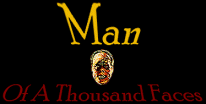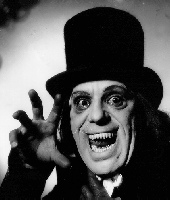 |
A Skullduggery
Spotlight
On Lon Chaney, Sr.
Page
3 |

Chaney's vampire
from
London After Midnight (1927)
Chaney made more noteworthy films in 1928 - 1929, albeit
in the obvious shadow cast by the booming era of radio - and the looming
era of "talking" motion pictures. These films included The
Big City, Laugh, Clown, Laugh, and another collaboration with
Tod Browning called, West Of Zanzibar. A few more films followed,
but the surging rise of the "talkies" was difficult to ignore,
even for a prominent star like Lon Chaney. 1928’s Thunder was
Chaney's last silent film. Although the film had some sound effects and
music, it was for the most part, a silent movie. Many film studios were
anxious to compete with the new and technically-superior "talking
pictures" pioneered by Warner Bros. Films like Thunder were
made with partial sound effects and did not do all that well when
compared to films that had complete sound. Released in 1929, Thunder
was not much of a success, as "talkies" were already in
existence for a year by that time.
Lon Chaney was among the last few big stars who held out
from making the transition to sound films. He had witnessed the careers
of long-standing silent film stars get wiped out almost overnight. While
a few like Greta Garbo and Ronald Colman were able to make the change
over to sound films (achieving greater stardom in the process), others,
such as John Gilbert - once the idol of millions - were ruined once they
opened their mouths. Chaney had dedicated too many years to his art to
chance watching his own career fizzle. Although he initially frowned on
this new innovation of sound in motion pictures, he was aware that he
either had to make the change over to "talkies", or announce
his retirement at the relatively young age of 46. When he finally made
his decision in early 1930, Lon was quoted: "No, retirement is the
bunk. And, yes…I am going into talkies! I'll tell you frankly that my
first talking picture is going to make - or break me! Inside. I mean…in
here…" as he tapped on his chest.
Chaney immersed himself in technical research around the
sound rooms; studying the art of recording and learning about the
recording devices of the era. He spent hours inside the mixing stages,
not only to observe the mixers at work, but to occasionally mix and
experiment himself. Chaney was making a study of sound recording
techniques with the same intensity and discipline that he'd previously
applied when studying the intricacies of physical and facial make-up.
Chaney's first sound film would be a remake of one of
his greatest box-office successes, The Unholy Three, which also
re-teamed him with Tod Browning. There were delays in the production of
the film though, as Chaney was apparently still ill from shooting his
last film Thunder. He was far more ill than even he thought so at
the time. Unable to fully recover from complications resulting from
bronchitis and a throat infection, Chaney underwent a tonsillectomy.
Still weak and considerably ill, he continued to shoot The Unholy
Three, although there were reports of a few occasions where he could
not summon up enough strength to leave his own dressing room. After
completing the film, Chaney immediately went to New York to undergo
medical tests. After consulting with several leading specialists, he
returned to his mountain retreat situated in the High Sierras of Inyo
National Forest.
The Unholy Three would be Lon Chaney's last film.
Released in July of 1930, the film was an instant success. Old and new
fans alike were anxious to hear Chaney talk for the first time. He
proved his versatility once again by imitating the voice of an old lady,
in addition to performing three other parts in the film. The film
received glowing reviews, and exceeded everyone’s expectations of Lon
Chaney, as it was now being pronounced that the "Man Of A Thousand
Faces is also The Man Of A Thousand Voices!" The studios were
already bus lining up new productions for him. Projects such as Cheri
Bibi, The Sea Bat, The Bugle Sounds, and Dracula
were being groomed for him. There were even rumors of Chaney being
considered for Universal's Frankenstein.
His strength failing rapidly, Chaney was brought into a
Hollywood hospital on August 1, 1930 for what was being diagnosed as
"acute anemia". After a number of blood transfusions, Chaney
seemed to be improving and was even removed from the critical list,
having safely gotten through a 10-day struggle. By the morning of August
25th, he was reported
in better condition; he had displayed an appetite and was even reported
to be somewhat talkative. At midnight, he suffered from a lung
hemorrhage that occurred so suddenly and unexpectedly - the physicians
failed to reach him before he passed away at 12:55 A.M. On the day of his
funeral, Thursday, August 28th, all work ceased throughout the Hollywood
film industry for five minutes.
At his death, Lon
Chaney was said to be worth around two-million dollars. His family -
with the exception of his first wife - were provided for by his will and
rather heavy insurance policies. His second wife Hazel passed away
several years later. In November of 1967, Cleva Creighton died of a
stroke at the age of 78, in a Sierra Madre nursing home.
Since his early
days as a prop boy, Lon Chaney always had a deep respect and sensitivity
toward stagehands and theatre craftsmen in general. So much in fact,
that he proudly retained his stagehands' union card up until the day he
died.
|